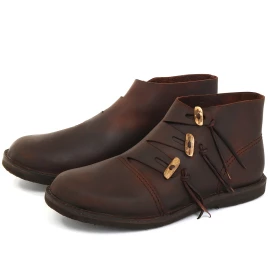Historical shoes

Contents
Beginnings
The most common material of prehistoric shoes was leather and necessary thermal insulation was provided by hay. Although their durability was usually quite short, these primitive shoes provided enough protection to its holder and they were still good alternative among poor people in later times when better solutions became available.
Ancient times and early Middle Ages
The ancient civilizations brought first specialized shoemakers, first differentiation between men’s and women’s footwear and we may already notice the fashion trends. Greeks and Romans are known for their sandals made of one piece of leather fastened by laces called carbatinae and roman military boots calligae. Interesting fact: Slaves were forbidden to wear any shoes at all and the tough people of old Sparta considered footwear to be a sign of softness and weakness and they rather walked barefoot.
Long time after the fall of the Rome did the European shoes still resembled the ancient ones but as the new kingdoms had risen and feudal lords and other important people demanded nice luxury shoes, their variety increased. Noblemen favoured closed shoes reaching over their ankles.
Gothic era
Gothic era is connected with characteristic long-toed upward-pointed men’s shoes called poulaines. Usually the longer the shoes were the higher social status their indicated. They might be more than twice longer than actual feet and had to be stuffed inside and tighten in order to allow normal walking. Sometimes they had a little jingle bell on each tip. People generally believed these stylish shoes were originated in Poland which is why they were called poulaines or crackowes (as from Cracow, Polish former capital). However, we are not sure where they came from. Some legends say that Fulk III, Count of Anjou, introduced the shoes in order to hide outgrow on his toe or it might have been English king Henry II because he had really big feet. Long toed shoes were preferred from the middle of 14th century to 1420s and then again in the second half of 15th century till they went out of fashion in 1480s.
Significant changes can be seen in military. Combatants began to wear iron sabatons-boots which were completing mail or later plate armours in 14th, 15th and 16th centuries. Even those were influenced by trendy long shoes so some statesmen and wealthy knights did not resist a possibility to be equipped with custom made sabatons a la poulaine.
Renaissance
Typical renaissance shoes had wide and flat tip which could be roundish or slightly pointed. Their shape gave them nicknames like Cow-Mouth shoes, Bear’s Claw shoes or Duck’s Bill shoes. Special platform shoes called chopines were introduced in Ottoman Empire and became very common among European high society women especially in the Republic of Venice. Platforms were mostly about 20 cm (8 inches) high but could reach up to 30 cm (1 foot) or even higher (which was illegal but occurring anyway) making walking really hard and the lady used to be accompanied by her maids who supported her. The chopines served as a protection of expensive dresses against getting dirty by avoiding them to touch the streets. The renaissance was also the first era of fashionable high heeled shoes.
Baroque and rococo
17th century people wore more decorated and theatrical shoes than their renaissance ancestors. Knee high calfskin cavalier boots featured with very wide bucket shaped cuffs became a new trend among upper class men. These times also the overshoes were introduced to prevent the shoe from getting muddy or wet. Women were hiding their shoes under long skirts so they were not that showy, however they could still be slightly expressive and decorated by rosettes or ribbons. Typical attribute of baroque footwear was (apart from previously mentioned pomposity) a square tip. After the end of the Thirty Years’ war the cavalier boots were replaced by shoes reaching only to the ankles often with very long tongue. The shoes were tightened by buckles.
During 18th century was Western world footwear influenced by a style called rococo. Cavalier boots were back again but this time they were folded from the top showing a lining of different colour. Shoes were still very decorative and heels were very popular among women and men wore them too, but lower ones. The tips became more and more pointed. It was a time of dance balls and waltz was the music of this era so the shoes had to be nice, representative and functional as well.
Late 18th century
Opulence and pomposity typical since the baroque era remained trendy until the times of the French revolution. The clogs became symbolical footwear of new republican era. These wooden shoes were worn on bare feet and sometimes stuffed with hay for higher comfort. Of course, the classic leather shoes did not disappeared but they looked less majestic and their silver buckles were replaced by batiste ribbons. About the end of the century, the military boots called Hessians spread among civilian men who used them not only for horse riding, which was their original use, but also for social events. Women’s shoes had narrow tips and heels lower than in previous times. They were also widely cut out over an instep so they had to be tightened by a lacing.
19th century
In the 19th century the technological progress was galloping faster than ever before and a lot of new things became available. Rubber vulcanization was discovered allowing to use rubber straps instead of lacing e.g. for Jodhpur boots or to make whole boots from rubber (Wellingtons). The change of life style resulted in new segments such as sport shoes or house slippers and variety of shoes grew rapidly. 19th century people generally began to demand elegance and quality rather than pomposity and decorativeness. The low shoes (like Oxfords) sometimes worn with the spats became quickly popular among men. Women wore typical ankle boots with high heels. The boots had lacing on their sides or buttons a little later.





Comments